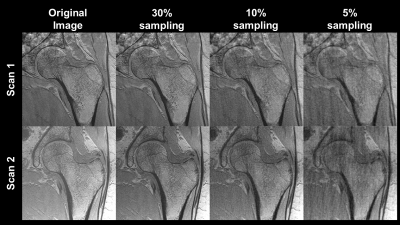Brian-Tinh Duc Vu1,2, Brandon Jones1,2, Winnie Xu2, Gregory Chang3, and Chamith Rajapakse2,4
1Bioengineering, University of Pennsylvania, Philadelphia, PA, United States, 2Radiology, University of Pennsylvania, Philadelphia, PA, United States, 3Radiology, Center for Biomedical Imaging, New York University, New York, NY, United States, 4Orthopaedic Surgery, Perelman School of Medicine, University of Pennsylvania, Philadelphia, PA, United States
1Bioengineering, University of Pennsylvania, Philadelphia, PA, United States, 2Radiology, University of Pennsylvania, Philadelphia, PA, United States, 3Radiology, Center for Biomedical Imaging, New York University, New York, NY, United States, 4Orthopaedic Surgery, Perelman School of Medicine, University of Pennsylvania, Philadelphia, PA, United States
High-resolution
hip images were retroactively undersampled and reconstructed with compressed
sensing. Fully sampled image quality and bone stiffness closely resembled
undersampling at 30% and the errors increased as the undersampling rate increased.

Representative images
for sparse reconstruction of retroactively undersampled MR data. At lower
sampling rates, less of the bone microstructure is apparent and more artifacts
occlude the reconstructed image.

(A) Binomial probability mass
function used to randomly select indices in k-space for undersampling. (B) Mask
of sample indices in k-space; white indicates a measurement, black an unused
k-space value. (C) Fully sampled 2-D slice of k-space of a typical MR image.
(D) Undersampled k-space based on mask indices.